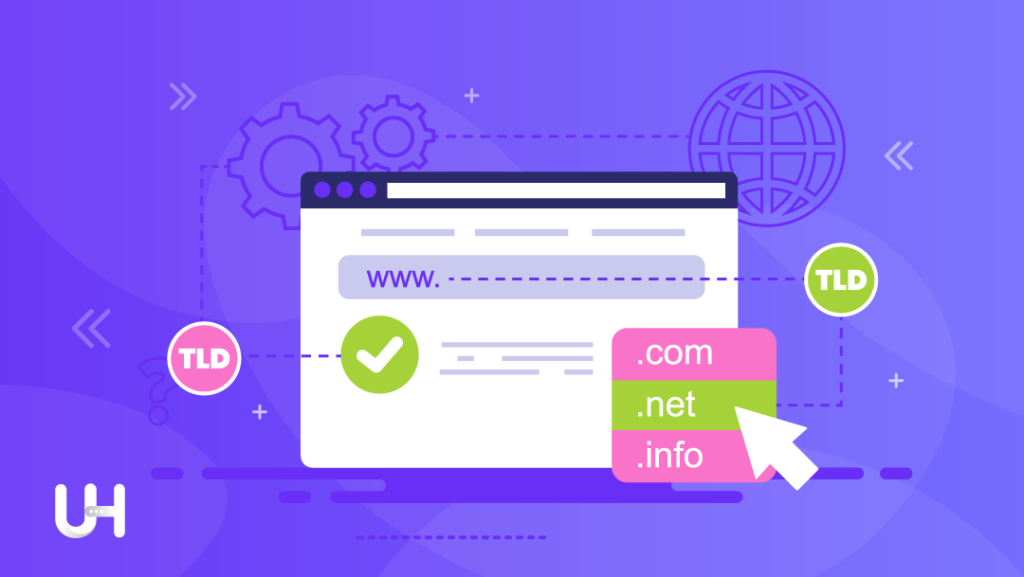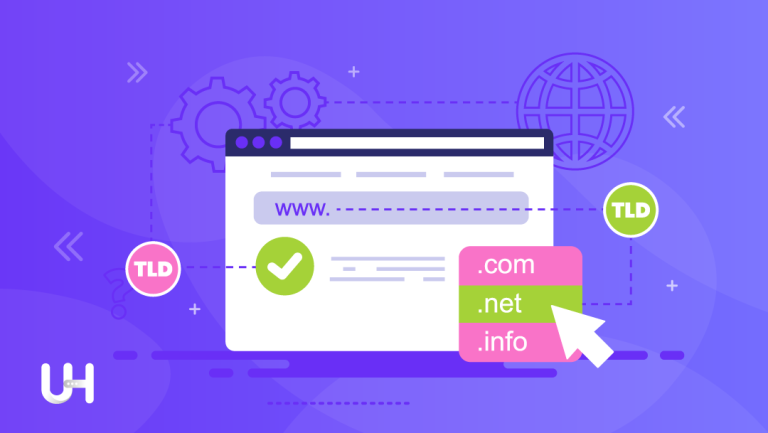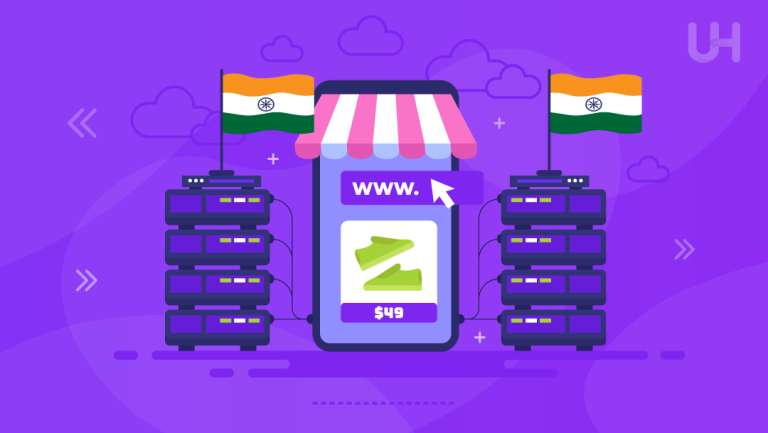Domain names are the digital addresses of the internet, crucial for establishing an online presence. They serve as the first point of contact between users and websites, shaping perceptions and facilitating accessibility. In the vast ecosystem of domain extensions, the .IN domain stands out as the country code top-level domain (ccTLD) for India. Much like .com or .org, .IN denotes a website’s association with India or its target audience within the country.
In this blog, we will explain what .IN domains are all about and how you can get one. Whether you’re a business wanting to reach Indian customers, someone who loves India, or just curious about .IN domains, this guide will help you understand everything you need to know.
What is a .IN domain?
It is a specific type of website address that ends with “.IN”, indicating its association with India. Think of it as a virtual address for websites, with “.IN” signaling that the content is related to India or targeted towards an Indian audience. This extension holds significance for businesses, organizations, and individuals looking to establish a digital presence in India’s thriving online landscape. It not only provides a sense of identity but also plays a crucial role in enhancing visibility and accessibility for Indian internet users.
The .IN domain extension has a rich history dating back to its introduction in 1989 as India’s country code top-level domain (ccTLD). Initially managed by the National Centre for Software Technology (NCST), it was later transitioned to the National Internet Exchange of India (NIXI) in 2005. Since then, .IN domains have witnessed a surge in popularity, serving as the online identity for countless businesses, organizations, and individuals across various industries. Today, this extension continues to evolve, serving as a gateway to the country’s diverse online community.
Types of .IN domains
Generic (e.g., .co.in, .net.in):
- .co.in: Among the most widely used extensions, .co.in is favored by commercial entities seeking to establish their online presence in India. Whether it’s e-commerce websites, service providers, or businesses of any scale, .co.in offers a recognizable and trustworthy option.
- .net.in: This extension caters to network-related organizations or businesses providing internet services within India. It’s commonly used by internet service providers, network infrastructure companies, and technology firms operating in the Indian market.
Restricted (e.g., .gov.in, .ac.in):
- .gov.in: Reserved exclusively for government entities at various levels, including national, state, and local government departments, agencies, and ministries. .gov.in domains signify official government websites, ensuring credibility and trustworthiness.
- .ac.in: Designed for educational institutions, including universities, colleges, research institutes, and academic bodies across India. .ac.in domains are a hallmark of academic excellence and scholarly endeavours, representing a diverse range of educational institutions nationwide.
How to Get a .IN Domain
Eligibility Criteria for Registration
Individuals vs. Organizations
Individuals: If you’re an Indian citizen or resident, or even a foreign individual residing in India, you’re eligible to register a .IN domain for personal use or non-commercial purposes. This means you can claim your online presence with a domain that represents you, your interests, or your personal projects.
Organizations: Businesses, government entities, educational institutions, and non-profit organizations in India can also register .IN domains. Whether you’re a small startup, a well-established corporation, a government agency, or an educational institution, it can serve as your digital address, helping you reach your target audience effectively.
Documentation Requirements
Individuals: When registering a .IN domain as an individual, you may be required to provide proof of identity. This could include documents such as your Aadhaar card, passport, or driver’s license. These documents help verify your identity and ensure compliance with registration guidelines.
Organizations: For businesses and organizations, valid documentation such as business registration certificates or PAN card may be necessary. These documents establish the legitimacy of your organization and confirm your eligibility for commercial or organizational purposes.
Where to Buy .IN domain?
NIXI (National Internet Exchange of India) accredits registrars authorized to offer .IN domain registration services. These registrars play a crucial role in facilitating the registration process and managing portfolios for registrants.
Factors to consider when selecting a registrar:
Pricing: Compare registration and renewal fees offered by different registrars to find the most cost-effective option that fits your budget. Keep in mind that pricing may vary based on additional services and features included in the registration package.
Customer support: Reliable customer support is essential for a smooth registration experience. Look for registrars that offer responsive customer support services, including live chat, email support, and phone assistance. Prompt and knowledgeable support can be invaluable, especially if you encounter any issues or technical challenges during the registration process.
Additional services offered: Beyond basic registration services, consider registrars that provide value-added services to enhance your online presence. These may include domain privacy protection, email hosting, website builders, SSL certificates, and other tools and resources to help you build and manage your website effectively.
Ready to Establish Your Online Presence in India?
Whether you’re a business looking to target an Indian audience effectively or establish a localized online presence, .IN domains offer a strategic advantage. Explore the power of .IN domains and kickstart your journey to digital success today!
Step-by-step Process For Registering a .IN domain
Checking Domain Availability
Start by using a search tool provided by registrars or online domain search platforms to check the availability of your desired name. Enter the domain name you’re interested in and conduct a search to see if it’s available for registration.
Ensure the domain name is unique and not already registered by another individual or organization. If your selected name is already taken, you may need to consider alternative options or variations that are available.
Registration Procedure
Once you’ve found an available name that meets your requirements, proceed to the registrar’s website for domain registration. Follow the steps outlined by the registrar to complete the registration form and provide the necessary information.
You’ll typically need to provide personal or organizational details, including your name, address, email address, and phone number. This information is used to create your domain registration account and associate the name with your contact information.
Review the registration details carefully to ensure accuracy before proceeding to the payment stage. Once you’ve confirmed the registration details and made payment for the registration fee, your .IN domain will be officially registered and activated.
Domain Management Tools
After successfully registering your .IN domain, take advantage of the management tools provided by the registrar to configure and manage your domain settings. These tools allow you to update contact information, manage DNS (Domain Name System) records, set up domain forwarding or masking, and monitor domain renewal dates.
Familiarize yourself with the domain management interface provided by the registrar to navigate the various options and settings available. Explore the different features and functionalities to customize the settings according to your preferences and requirements.
Keep track of important dates such as the renewal date to ensure uninterrupted ownership. Set up automatic renewal options or reminders to receive notifications when the renewal is due, helping you avoid any lapses in domain ownership.
Tips for Selecting the Right .IN Domain Name
Choosing the perfect name requires careful consideration and strategic thinking. Here are some detailed tips to help you select:
Understand Your Brand Identity
Before selecting a .IN domain name, take the time to understand your brand identity, values, and target audience. Your domain name should reflect your brand’s personality and resonate with your target audience. Consider the tone, voice, and messaging that best represent your brand.
Keep it Short and Memorable
A short and memorable name is easier to remember and type into a browser. Aim for a name that is concise, easy to spell, and pronounce. Avoid using complex words, hyphens, or numbers that can confuse users and make it difficult for them to recall your domain name.
Incorporate Keywords
Including relevant keywords in your Indian domain name can improve your website’s visibility in search engine results. Conduct keyword research to identify popular search terms related to your industry, products, or services, and integrate them naturally into your domain name. This can help improve your website’s SEO and attract targeted traffic.
Consider Brand Alignment
The name should align with your brand identity and offerings. Choose a domain name that reflects your brand name, products, services, or value proposition. Your domain name should instantly convey what your website is about and create a positive impression on visitors.
Check Availability and Trademarks
Before finalizing, check its availability and ensure that it doesn’t infringe on existing trademarks. Conduct a thorough search on registration platforms to see if your desired name is available for registration. Additionally, check trademark databases to verify that your chosen domain name is not already trademarked by another entity.
Consider Localization
If you’re targeting a specific region or audience within India, consider incorporating localized elements into your Indian domain name. This could include using city or state names, regional terms, or language-specific keywords to make your domain name more relevant to your target audience. Moreover, localization can help you connect with users on a deeper level and improve your website’s appeal to local audiences.
Think Long-Term
When selecting a .IN domain name, think about its long-term implications and how it will serve your brand in the future. Choose a name that is versatile and scalable, allowing room for growth and expansion. Avoid using overly specific or limiting names that may restrict your brand’s evolution over time.
By following these detailed tips, you can select a .IN domain name that aligns with your brand identity, resonates with your target audience, and sets the foundation for a successful online presence in India. Moreover, take the time to research, brainstorm, and evaluate your options to choose a name that reflects your brand’s values and objectives effectively.
Post-registration Considerations
Once you’ve successfully registered your Indian domain, there are several important considerations to keep in mind to maximize its effectiveness and ensure a smooth online presence. Here are some key post-registration considerations:
Website Development
After registering your Indian domain, it’s time to create your WordPress website with affordable Indian WordPress Hosting. Whether you’re creating a personal blog, e-commerce store, or corporate website, focus on designing a user-friendly interface, optimizing for mobile devices, and creating valuable content that resonates with your target audience.
Content Strategy
Develop a content strategy to keep your website fresh, relevant, and engaging. Create an effective content calendar and regularly update your website with high-quality content, including blog posts, articles, product descriptions, and multimedia content such as videos and infographics. This not only improves your website’s search engine ranking but also keeps visitors coming back for more.
Security Measures
Protect your website and data from security threats by implementing robust security measures. Install SSL/TLS certificates to encrypt data transmission, regularly update software and plugins to patch vulnerabilities, and use strong passwords to prevent unauthorized access. Consider investing in website security tools and services to safeguard your online assets.
Regular Maintenance
Keep your website running smoothly by performing regular maintenance tasks. This includes monitoring website performance, checking for broken links, updating content and software, and backing up data regularly. Regular maintenance ensures that your website remains secure, reliable, and accessible to users.
Marketing and Promotion
Promote your website to attract visitors and drive traffic. Utilize a mix of online marketing channels such as social media, email marketing, content marketing, and paid advertising to reach your target audience and increase brand awareness.
Analytics and Tracking
Monitor your website’s performance and track key metrics using analytics tools. Analyze website traffic, user behavior, conversion rates, and other performance indicators to identify areas for improvement and optimize your website for better results. Moreover, use data-driven marketing insights to make informed decisions and continually refine your online strategy.
Transferring an Existing Domain to .IN extension

Transferring an existing domain to .IN extension involves specific requirements, processes, and considerations. Here’s what you need to know:
Requirements and Process for Transferring
Eligibility: Ensure that you meet the eligibility criteria set by the National Internet Exchange of India (NIXI) for transferring a domain to the .IN extension. Generally, individuals, businesses, organizations, and entities eligible to register an Indian domain can also transfer existing domains to the .IN extension.
- Initiate Transfer: Log in to your chosen registrar’s website and initiate the domain transfer process. Provide the domain name you wish to transfer and enter the authorization code when prompted. Follow the instructions provided by the registrar to complete the transfer request.
- Verification and Confirmation: Once you’ve initiated the transfer request, your current registrar will send an email notification to the administrative contact listed in the domain’s WHOIS record. Verify the transfer request and follow any instructions provided by your current registrar to confirm the transfer.
- Transfer Approval: After confirming the transfer request, your current registrar will release the domain to the .IN registry for processing. The .IN registry will notify your new registrar of the transfer request and initiate the transfer process.
- Domain Verification: The .IN registry may conduct verification checks to ensure the legitimacy of the transfer request. This may involve contacting the domain owner or administrative contact to confirm the transfer request’s authenticity.
- Transfer Completion: Once the transfer is approved and processed by the .IN registry, your domain will be transferred to your new registrar’s account. You will receive confirmation from both your new registrar and the .IN registry once the transfer is complete.
Potential Challenges During the Transfer Process
- Domain Lock: Ensure that your domain is not subject to any registrar or registry locks that could prevent the transfer process. Contact your current registrar to unlock the domain if necessary before initiating the transfer.
- Domain Expiry: Be mindful of your domain’s expiration date during the transfer process. It’s advisable to initiate the transfer well in advance of the domain’s expiry to avoid any disruptions to your website or online services.
- Administrative Contact Information: Ensure that the administrative contact listed in the domain’s WHOIS record is up to date and accessible. This contact may receive important notifications and verification requests during the transfer process.
- Transfer Authorization Code: Double-check the accuracy of the authorization code provided by your current registrar before initiating the transfer. Moreover, an incorrect or invalid authorization code can delay or hinder the transfer process.
- Communication with Registrars: Maintain open communication with both your current registrar and the registrar handling the transfer to address any issues or concerns promptly.
Benefits of Using a .IN domain
Enhanced Local Relevance and Trustworthiness
A .IN domain instantly communicates to internet users that your website is relevant to India. This local relevance fosters trust and credibility among Indian audiences, as they perceive your website as being tailored to their needs and interests. By choosing a .IN domain, you demonstrate your commitment to serving the Indian market, which can significantly enhance your reputation and attract more visitors to your website. When users see a .IN domain, they immediately recognize it as being associated with India, which helps establish trust and credibility, leading to higher conversion rates.
Accessibility to the Indian Market
With a .IN domain, you gain improved accessibility to the vast Indian market. Search engines prioritize country-specific domains in their search results, making it easier for Indian users to find and engage with your website. This enhanced visibility increases your chances of reaching your target audience in India, driving more traffic to your website and expanding your reach within the Indian market. Additionally, having a .IN domain can improve your website’s ranking in local search results, making it more visible to users searching for relevant information, products, or services in India.
Branding Opportunities
A .IN domain offers unique branding opportunities for businesses and organizations looking to establish a strong presence in India. You can create a memorable and meaningful domain name that reflects your brand identity, values, and offerings. Whether you’re a local business, multinational corporation, or start-up, a .IN domain allows you to customize your online identity to resonate with Indian consumers and differentiate yourself from competitors. With a .IN domain, you can create a brand presence that is uniquely Indian, helping you connect with your target audience on a deeper level and build lasting relationships with customers.
SEO Benefits
Incorporating relevant keywords into your Indian domain name can improve your website’s search engine optimization (SEO) performance. Search engines consider domain names when determining the relevance and authority of a website for specific search queries. By choosing a .IN domain that includes keywords related to your industry, products, or services, you can increase your website’s visibility in search engine results and attract more organic traffic from Indian users. Additionally, having a .IN domain can improve your website’s local SEO, making it more likely to appear in local search results for users in India.
Protection of Intellectual Property
Registering a .IN domain can help protect your intellectual property rights in India. By securing your brand name or trademarks as a .IN domain, you prevent unauthorized third parties from registering similar domain names that could potentially infringe on your intellectual property. This proactive approach to domain management safeguards your brand identity and reputation in the Indian market, reducing the risk of brand dilution or infringement. Additionally, having a .IN domain can help prevent cybersquatting, where individuals or organizations register domain names similar to existing trademarks in an attempt to profit from their goodwill.
Geographic Targeting Capabilities
A .IN domain allows you to target specific geographic regions within India, enabling you to customize your online presence based on regional preferences and demographics. Whether you’re targeting users in metro cities, rural areas, or specific states, a .IN domain provides geographic targeting capabilities that help you tailor your marketing efforts and content to resonate with local audiences. This can be particularly beneficial for businesses with a physical presence in India, such as local retailers or service providers, who want to attract customers from specific regions.
Potential for Increased Traffic and Conversions
By leveraging the trust and credibility associated with Indian domains, you can attract more visitors to your website and increase your chances of converting them into customers or clients. Indian internet users are more likely to click on websites with Indian domains, as they perceive them as being more relevant and trustworthy. This increased trust can lead to higher click-through rates, more engagement, and ultimately, more conversions for your business. With a domain, you can tap into the growing Indian market and capitalize on the opportunities it presents for business growth and expansion.
Legal and Regulatory Considerations
Ensuring compliance with Indian domain registration regulations is essential when acquiring a .IN domain. It’s crucial to understand the legal framework and guidelines established by the National Internet Exchange of India (NIXI) for registering and managing Indian domains.
Protection of intellectual property rights is another critical aspect to consider. It’s essential to safeguard your trademarks, copyrights, and other intellectual property assets when registering an Indian domain. Conducting thorough research to ensure your chosen domain name does not infringe on existing trademarks or copyrights is imperative to avoid legal issues.
Understanding domain ownership and transfer rights is vital for clarity and transparency in domain management. Familiarize yourself with the terms and conditions of domain registration, including ownership rights, renewal procedures, and transfer policies. Knowing your rights as a domain owner can help prevent misunderstandings and disputes in the future.
Conclusion
In conclusion, opting for a .IN domain presents a myriad of advantages and opportunities for individuals, businesses, and organizations seeking to establish a strong online presence in India. From enhanced local relevance and trustworthiness to improved accessibility to the Indian market, the benefits of choosing an Indian domain are abundant.
By selecting a .IN domain, you signal your commitment to serving the Indian audience and differentiate yourself from competitors. You gain unique branding opportunities to connect with Indian consumers on a deeper level and tailor your online identity to resonate with their preferences and interests.
If you’re ready to take the next step in establishing your online presence in India, consider leveraging the power of our reliable Indian VPS hosting. With cutting-edge technology and top-notch support, Ultahost offers tailored solutions to meet your hosting needs.
FAQ
What does .IN stand for?
.IN stands for “India.” It is the country code top-level domain (ccTLD) for India.
What is the purpose of an Indian domain name?
The purpose of a Indian domain is to signify websites that are associated with India or target an Indian audience specifically.
Who can register a .IN domain?
Individuals, businesses, organizations, and entities both within and outside of India can register a .IN domain.
What are some benefits of using a .IN domain?
Some benefits of using a .IN domain include enhanced local relevance and trustworthiness, improved accessibility to the Indian market, branding opportunities, and SEO benefits.
What factors should be considered when selecting an IN domain name?
When selecting, factors to consider include brand alignment, memorability, keyword incorporation, availability, trademark checks, and localization.
















